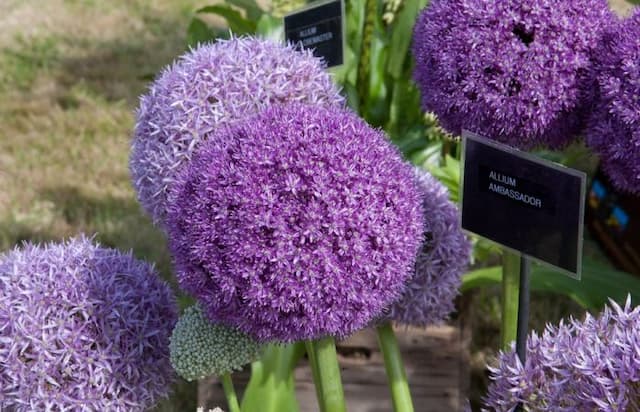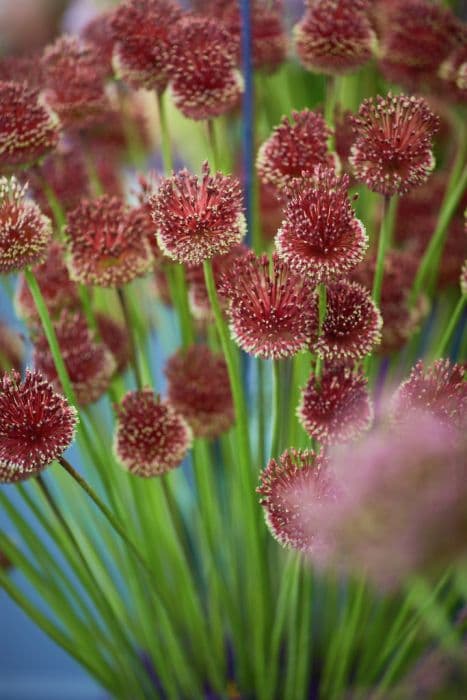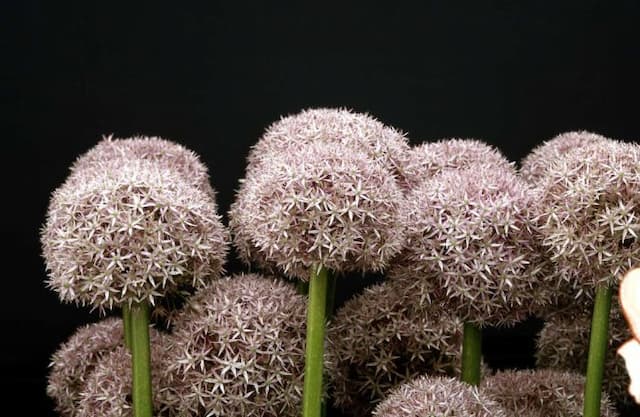Ornamental onion Allium 'Purple Rain'

ABOUT
Allium 'Purple Rain' is characterized by its distinctive, ornamental flowers that boast a rich purple hue, making this plant a striking addition to any garden setting. The blooms are comprised of numerous small, star-shaped flowers tightly clustered together, forming a globe-like shape that perches atop sturdy stems. These spherical flower heads give a dramatic contrast against the backdrop of the garden's greenery. The foliage of the Allium 'Purple Rain' is generally strap-shaped, with a lush green color that complements its vivid purple flowers. The leaves typically emerge from the base of the plant and provide a verdant setting before the stems and flowers rise above them during the flowering season. The plant possesses an architectural elegance that is a magnet for pollinators and a delight for garden enthusiasts, it adds an accent of royal color and a textural dimension wherever it is planted.
About this plant
 Names
NamesFamily
Amaryllidaceae
Synonyms
Ornamental Onion, Flowering Onion, Purple Rain Allium
Common names
Allium 'Purple Rain'.
 Toxicity
ToxicityTo humans
Allium 'Purple Rain', commonly known as ornamental onion, is not typically considered toxic to humans when touched or ingested in small quantities. However, all parts of the plant can cause gastrointestinal irritation if ingested in large amounts, due to the presence of various sulfur compounds. Symptoms may include nausea, vomiting, and diarrhea. It's important to note that sensitivity to these plants can vary among individuals, and while rare, some may experience a more severe reaction. Always practice caution and consult with a medical professional if any significant quantity has been ingested or if any adverse reactions occur.
To pets
Ornamental onion is toxic to pets, including dogs and cats. All parts of the plant contain compounds that can be harmful if ingested. The toxicity is primarily due to the presence of thiosulphates, which can cause oxidative damage to red blood cells leading to hemolytic anemia. Symptoms of poisoning in pets can include vomiting, diarrhea, abdominal pain, loss of appetite, and possible respiratory issues. Advanced signs can include lethargy, pale gums, and even collapse. If you suspect your pet has ingested this plant, immediate veterinary attention is essential.
 Characteristics
CharacteristicsLife cycle
Perennials
Foliage type
Deciduous
Color of leaves
Green
Flower color
Purple
Height
2-3 feet (0.6-0.9 meters)
Spread
1-2 feet (0.3-0.6 meters)
Plant type
Bulb
Hardiness zones
4-8
Native area
Central Asia
Benefits
 General Benefits
General Benefits- Attractive Flowers: Adds visual interest to gardens with its striking purple blooms.
- Pollinator Friendly: Attracts bees, butterflies, and other beneficial insects which are vital for pollination.
- Easy to Grow: Requires minimal care and can thrive in most garden soils, making it suitable for gardeners of all skill levels.
- Drought Tolerant: Once established, it is quite hardy and can withstand periods of low rainfall.
- Deer Resistant: Its odor and taste are typically unappealing to deer, reducing the risk of damage.
- Long Blooming Period: Provides color and interest in the garden throughout the growing season.
- Multiplies Easily: Can naturally multiply each year, providing more plants over time.
- Low Maintenance: It doesn’t require frequent watering or fertilizing, saving time and resources.
- Culinary Use: Some parts of the plant may be edible and can be used in cooking for flavoring, similar to other allium species.
- Ornamental and Functional: Adds both beauty and function to a garden as part of a border, container, or as a cut flower for arrangements.
- Good for Wildlife: Provides nectar and habitat for wildlife, supporting biodiversity.
 Medical Properties
Medical PropertiesThis plant is not used for medical purposes.
 Air-purifying Qualities
Air-purifying QualitiesThis plant is not specifically known for air purifying qualities.
 Other Uses
Other Uses- The long, sturdy stems of Allium 'Purple Rain' can be used in flower arrangements and bouquets to add height and structure, giving a striking contrast to other blooms.
- Allium 'Purple Rain' can be planted in and around vegetable gardens as a form of companion planting to deter certain pests like aphids and carrot fly.
- The dried seed heads of Allium 'Purple Rain' make for an interesting addition to dried floral arrangements, lasting for several months or even years.
- Dried allium heads can be sprayed with metallic paint and used as decorations during festive seasons such as Christmas or Thanksgiving.
- Photographers and artists can utilize the unique shape and color of Allium 'Purple Rain' as a subject for botanical illustration, photography, and art projects.
- The seeds of Allium 'Purple Rain' can be collected and used to propagate new plants, which can be a fun educational activity for children and gardening enthusiasts.
- Incorporating Allium 'Purple Rain' into a wildlife-friendly garden can attract pollinators such as bees and butterflies, which are important for the ecosystem.
- The bloom of Allium 'Purple Rain' provides a dramatic focal point in garden photography, especially when captured during the golden hour for enhanced color saturation.
- Allium 'Purple Rain' can serve as a natural marker for garden divisions or pathways, with its distinctive height and color providing clear and decorative boundaries.
- Gardeners can use Allium 'Purple Rain' bulbs in a "forcing" process to bloom indoors, allowing one to enjoy their beauty outside of the typical growing season.
Interesting Facts
 Feng Shui
Feng ShuiThe Ornamental Onion is not used in Feng Shui practice.
 Zodiac Sign Compitability
Zodiac Sign CompitabilityThe Ornamental Onion is not used in astrology practice.
 Plant Symbolism
Plant Symbolism- Unity: As a member of the Allium family, 'Purple Rain' signifies unity due to the tightly clustered florets that make up its spherical head, representing how multiple parts can come together as a whole.
- Good Fortune: In some cultures, Alliums are associated with good fortune and prosperity, so the 'Purple Rain' variety can be seen as a harbinger of luck.
- Strength and Resilience: These plants have strong stems that support their round flower heads, symbolizing the ability to stand firm and endure challenges.
- Protection: Historically, Alliums were thought to have protective qualities, warding off evil spirits and negative energies. 'Purple Rain' can embody this protective symbolism as well.
- Humility: Despite their showy appearance, the 'Purple Rain' Allium grows from humble bulbs in the ground, which can symbolize modest beginnings leading to impressive outcomes.
 Water
WaterOrnamental onions, like 'Purple Rain', should be watered thoroughly once the top inch of soil feels dry. In general, this equates to about once a week during the growing season, although the frequency may increase in extremely hot or dry conditions. Provide enough water to moisten the soil to a depth of about 6 inches, which can be roughly around 1 to 1.5 gallons depending on the size and maturity of the plant and the soil's ability to retain moisture. Less frequent watering helps encourage deep root growth. During the dormant season, reduce watering significantly as the plant requires a drier soil to prevent bulb rot.
 Light
LightOrnamental onions, such as 'Purple Rain', thrive in full sun, which means they need at least 6 to 8 hours of direct sunlight each day. Planting them in a spot where they receive ample sunshine throughout the day is ideal. They can tolerate partial shade, but flowering may be reduced in less than optimal light conditions.
 Temperature
TemperatureOrnamental onions, including 'Purple Rain', prefer a temperature range of 60-70°F for optimal growth but can tolerate temperatures as low as 28°F and as high as 90°F. Sudden extreme changes in temperature should be avoided to prevent stress on the plant.
 Pruning
PruningPruning ornamental onions, such as 'Purple Rain', is generally done to remove spent flower stems and tidy up the plant. After blooming, trim the flower stalks back to the base of the plant to encourage proper nutrients to the bulb for the next season. Pruning is not frequently required but is best done in late summer or fall after the flowers have faded.
 Cleaning
CleaningAs needed
 Soil
SoilAllium 'Purple Rain', commonly known as Ornamental Onion, thrives best in loamy soil with good drainage and a pH ranging from 6.0 to 7.5. A mix consisting of two parts garden soil, one part compost, and one part sand or perlite would create an ideal environment for this plant.
 Repotting
RepottingOrnamental Onions, including Allium 'Purple Rain', typically do not require frequent repotting and can be repotted every 3 to 4 years or when the bulbs outgrow their current space.
 Humidity & Misting
Humidity & MistingOrnamental Onion 'Purple Rain' is tolerant of a wide range of humidity levels and does not have specific humidity requirements, making it versatile and easy to care for in various environments.
 Suitable locations
Suitable locationsIndoor
Ensure full sun and well-draining soil for Ornamental Onion 'Purple Rain'.
Outdoor
Plant in full sun, well-drained soil; mulch in winter if needed.
Hardiness zone
Allium 'Purple Rain', or Ornamental Onion, is suitable for USDA zones 4-8.
 Life cycle
Life cycleAllium 'Purple Rain', commonly known as ornamental onion, begins its life cycle with seed germination, typically in early spring when soil temperatures rise. The seeds develop into small bulbs, which then produce thin, grass-like leaves as part of the vegetative growth stage. As the plant matures, it will enter the reproductive stage, characterized by the formation of a tall stem that bears a striking, spherical cluster of star-shaped purple flowers. After the flowering period, which occurs in late spring to early summer, the plant will set seed as the flowers fade and the seed heads dry. The seeds can be dispersed by wind or wildlife, completing the cycle of reproduction. Finally, the plant enters a period of dormancy in late summer or fall, where the foliage dies back, and the bulb rests until the next growing season.
 Propogation
PropogationPropogation time
Spring-Early Summer
Propogation: The Allium 'Purple Rain', commonly known as ornamental onion, is generally propagated by dividing the bulbs. The optimal time for this procedure is in the fall after the leaves have died back or in the early spring before growth begins. To propagate, carefully dig up the bulb clumps and gently separate them into individual bulbs, making sure that each division has at least one shoot or piece of the original bulb attached to ensure successful growth. After separation, the bulbs should be immediately replanted at a depth of about three times the diameter of the bulb, which is typically 6 to 8 inches (15 to 20 centimeters), spaced about 8 to 10 inches (20 to 25 centimeters) apart to allow for ample growing space. This method leverages the plant's natural reproduction cycle and is the most straightforward and commonly used approach to increase the numbers of Allium 'Purple Rain' in the garden.









